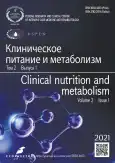Венозный доступ для парентерального питания: что изменилось за последние 12 лет в Европе и Северной Америке?
- Авторы: Курмуков И.А.1, Обухова О.А.2
-
Учреждения:
- Национальный медицинский исследовательский центр онкологии им. Н.Н. Блохина
- Национальный медицинский исследовательский центр онкологии имени Н.Н. Блохина
- Выпуск: Том 2, № 1 (2021)
- Страницы: 5-12
- Раздел: Научные обзоры
- URL: https://journals.rcsi.science/2658-4433/article/view/79378
- DOI: https://doi.org/10.17816/clinutr79378
- ID: 79378
Цитировать
Аннотация
В статье представлен обзор существенных изменений клинической практики, произошедших со времени публикации рекомендаций Европейской ассоциации клинического питания и метаболизма по обеспечению сосудистого доступа для парентерального питания в отношении выбора сосудистого доступа, профилактики и лечения наиболее частых осложнений длительно используемого венозного доступа ― катетерассоциированной инфекции кровотока и обструкции внутреннего просвета катетеров.
Предпочитаемый сосудистый доступ при средне- и долговременном парентеральном питании ― туннелируемый центральный венозный катетер, периферически имплантируемый центральный венозный катетер или полностью имплантируемая порт-система ― теперь в значительной степени определяется основным заболеванием, ближайшим прогнозом жизни и комфортом пациента, а при кратковременном парентеральном питании в стационаре ― в большей степени зависит от возможностей конкретного лечебного учреждения. Строгое соблюдение современных стандартных мер инфекционного контроля и ухода за венозным доступом и инфузионными линиями, гигиена рук, а также соответствующее обучение медицинского персонала, пациентов и ухаживающих за ними лиц являются в настоящее время самыми надёжными и эффективными способами профилактики катетерассоциированной инфекции кровотока. В качестве дополнительной меры применяется «замок катетера» тауролидином. Окклюзия внутреннего канала катетера в большинстве случаев может быть устранена лекарственным методом, однако его эффективность непосредственно зависит от соответствия выбранного препарата причине окклюзии.
В целом, произошедшие в последние годы изменения позволили значительно уменьшить частоту и опасность осложнений парентерального питания, связанных с сосудистым доступом.
Полный текст
Открыть статью на сайте журналаОб авторах
Илдар Анварович Курмуков
Национальный медицинский исследовательский центр онкологии им. Н.Н. Блохина
Email: kurmukovia@gmail.com
ORCID iD: 0000-0001-8463-2600
SPIN-код: 3692-5202
к.м.н.
Россия, 115487, Москва, ул. Каширское шоссе, 24Ольга Аркадьевна Обухова
Национальный медицинский исследовательский центр онкологии имени Н.Н. Блохина
Автор, ответственный за переписку.
Email: obukhova0404@yandex.ru
ORCID iD: 0000-0003-0197-7721
SPIN-код: 6876-7701
кандидат медицинских наук
Россия, 115487, Москва, Каширское шоссе, 24Список литературы
- Pittiruti M., Hamilton H., Biffi R., et al. ESPEN Guidelines on parenteral nutrition: central venous catheters (access, care, diagnosis and therapy of complications) // Clin Nutr. 2009. Vol. 28, N 4. Р. 365–377. doi: 10.1016/j.clnu.2009.03.015
- ESPEN Guidelines & Consensus Papers [updated 07 September 2021]. Режим доступа: https://www.espen.org/guidelines-home/espen-guidelines. Дата обращения: 07.09.2021.
- Pironi L., Boeykens K., Bozzetti F., et al. ESPEN guideline on home parenteral nutrition // Clin Nutr. 2020. Vol. 39, N 6. Р. 1645–1666. doi: 10.1016/j.clnu.2020.03.005
- Обухова О.А., Кашия Ш.Р., Курмуков И.А., и др. Влияние полного парентерального питания на метаболические процессы в раннем послеоперационном периоде у онкологических больных // Общая реаниматология. 2011. Т. 7, № 2. С. 51–55.
- Pronina A., Kurmukov I., Kashia S. Totally implantable venous access ports (TIVAPs) in cancer patients (pts): safety of implantation in intensive care unit (ICU) and opportunity for immediate use // Critical Care. 2019. Vol. 23, Suppl. 2. Р. 72–193.
- Kovacevich D.S., Corrigan M., Ross V.M., et al. American Society for Parenteral and Enteral Nutrition guidelines for the selection and care of central venous access devices for adult home parenteral nutrition administration // J Parenter Enteral Nutr. 2019. Vol. 43, N 1. Р. 15–31. doi: 10.1002/jpen.1455
- Hortencio T.D., Arendt B.M., Teterina A., et al. Changes in home parenteral nutrition practice based on the canadian home parenteral nutrition patient registry // J Parenter Enteral Nutr. 2017. Vol. 41, N 5. Р. 830–836. doi: 10.1177/0148607115609289
- Saqui O., Fernandes G., Allard J. Central venous catheter infection in Canadian home parenteral nutrition patients: a 5-year multicenter retrospective study // Br J Nurs. 2020. Vol. 29, N 8. Р. S34–S42. doi: 10.12968/bjon.2020.29.8.S34
- Vashi P.G., Virginkar N., Popiel B., et al. Incidence of and factors associated with catheter-related bloodstream infection in patients with advanced solid tumors on home parenteral nutrition managed using a standardized catheter care protocol // BMC Infect Dis. 2017. Vol. 17, N 1. Р. 372. doi: 10.1186/s12879-017-2469-7
- Wouters Y., Causevic E., Klek S., et al. Use of catheter lock solutions in patients receiving home parenteral nutrition: a systematic review and individual-patient data meta-analysis // J Parenter Enteral Nutr. 2020. Vol. 44, N 7. Р. 1198–1209. doi: 10.1002/jpen.1761
- Gundogan K., Dave N.J., Griffith D.P., et al. Ethanol lock therapy markedly reduces catheter-related blood stream infections in adults requiring home parenteral nutrition: a retrospective study from a tertiary medical center // J Parenter Enteral Nutr. 2020. Vol. 44, N 4. Р. 661–667. doi: 10.1002/jpen.1698
- Dibb M., Lal S. Home parenteral nutrition: vascular access and related complications // Nutr Clin Pract. 2017. Vol. 32, N 6. Р. 769–776. doi: 10.1177/0884533617734788
- Allan P.J., McMahon M., Abraham A., et al. Reduced need for replacement of long term parenteral nutrition catheters following endoluminal brushing // Clin Nutr. 2015. Vol. 34, N 1. Р. 146–150. doi: 10.1016/j.clnu.2014.02.006
Дополнительные файлы







